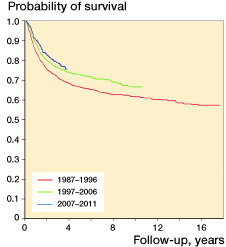Figures & data
Table 1. Total numbers (percentages) of patients registered in 5 time periods since the start of the Scandinavian Sarcoma Group Central Register, which includes population data from Norway, Finland, and Sweden
Table 2. Variables that must be recorded to qualify for inclusion in the Scandinavian Sarcoma Group Central Register for extremity and trunk wall sarcoma
Table 3. Distribution of histological subtypes of sarcomas in different time periods in the Scandinavian Sarcoma Group Central Register
Table 4. Distribution of malignancy grades among 5,462 soft tissue sarcomas according to Broders respectively 210 according to FNCLCCTable Footnotea in different time periods. Rare sarcomas, traditionally not graded are excluded
Table 5. Percentage of cases and total number of cases referred to sarcoma center virgin (including fine-needle or coarse-needle biopsy) or after surgical procedures/recurrence in 3 time periods, as reported in the Scandinavian Sarcoma Group Central Register
Table 6. Site and depth of tumors in soft-tissue sarcoma (STS) cases according to time period, as reported in the Scandinavian Sarcoma Group Central Register
Figure 1. Cumulative local recurrence rate according to margins in 4,143 patients treated with curative intent at centers with >4 years of follow-up of more than 75% of surviving patients (p < 0.001). All margins tested against the others. Analysis was terminated at 100 cases left at risk.

Figure 2 Metastasis-free survival in 4,153 patients surgically treated in 3 time periods at centers with >4 years of follow-up of more than 75% of surviving patients (p < 0.005). The period 1987–1996 was tested against the others. Analysis was terminated at 100 cases left at risk.

Figure 3. Plot and results from Cox model of metastasis-free survival in 3,842 patients with soft-tissue sarcoma, according to 5 continuously reporting hospitals in the Scandinavian Sarcoma Group Central Register. The Cox model included sex, age at diagnosis, tumor size, tumor depth, and malignancy grade. The plots are specified for male sex, age =59 years, tumor size =8.1 cm, deep tumor location, and high grade of malignancy.

Table 7. Final margin distribution (%) and proportion of patients receiving radiation treatment according to margin status among 5,071 patients from the Scandinavian Sarcoma Group Central Register. The proportion of patients with a wide margin decreased (p < 0.001) and the proportion of patients having radiation treatment increased (p < 0.001)
